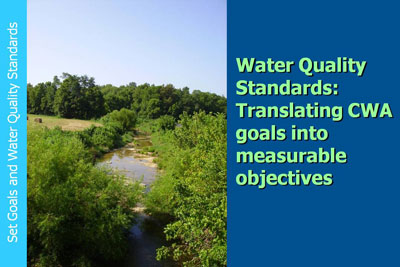Introduction to WQS
Water quality standards (WQS) are aimed at translating the broad goals of the CWA into water body-specific objectives. Ideally, WQS should be expressed in terms that allow quantifiable measurement. WQS, like the CWA overall, apply only to the waters of the United States. As defined in the CWA, “waters of the United States” include only surface waters—such as streams, rivers, lakes, estuaries, coastal waters, and wetlands. Not all surface waters are legally “waters of the United States.” Generally, however, those waters include the following:
- All waters that are traditionally navigable
- All interstate waters
- Intrastate waters used in interstate and/or foreign commerce
- Tributaries of the above
- Territorial seas at the cyclical high tide mark
- Wetlands adjacent to all the above
![[logo] US EPA](https://www.epa.gov/epafiles/images/logo_epaseal.gif)
